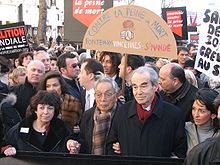- Sakae Menda
-
Sakae Menda 
Born November 4, 1925
JapanConviction(s) Murder Penalty Death Status Acquitted after retrial Occupation Activist Spouse Tamae Menda Sakae Menda (免田栄 Menda Sakae, born November 4, 1925) is a Japanese man who was convicted of a double homicide, but was exonerated by retrial in 1983. This was the first time anyone was ever released from death row by retrial in Japan. He is now a leading figure in Japan for the movement to abolish the death penalty.[1]
Contents
Background
On December 30, 1948, an unknown killer broke into the house of a 76-year-old Buddhist priest and his wife in Kumamoto Prefecture in Kyushu and murdered them using an axe and a knife. The killer also wounded their two young daughters. During the same period, Sakae Menda was arrested on the charge of stealing rice.
Arrest and trial
Police held Menda for three weeks, without allowing him access to a lawyer, until they extracted a confession. During interrogation, he was starved of food, water and sleep, and beaten with bamboo sticks while being suspended upside down from a ceiling. The police eventually coerced Menda into signing a written statement. He was tried and was convicted of double homicide despite pleading innocent. On March 23, 1950, Judge Haruo Kinoshita sentenced him to death. The Supreme Court of Japan upheld his sentence on December 25, 1951. A lawyer only came to see Menda once before the trial. The lawyer, a Buddhist monk, came to pray for him, but offered no professional expertise to help him fight the charges. His trial did not include any physical evidence or the witness accounts that proved Menda had an alibi. He was wrongly convicted of murder and robbery based on the false confession.[2]
Incarceration
Menda was incarcerated at the Fukuoka Detention Center in solitary confinement. He was held in an unheated cell that was lit day and night and monitored constantly.
Under the Japanese 1907 penal code, death row inmates, unless they are involved in legal appeals, could be taken away for execution at prison gallows at any time, with little notice. Executions in Japan are typically held in secret, and prisoners are either not warned of their impending execution or are notified only on the morning of the day of the execution. Their families are informed later so they can collect the corpse for cremation.[3]
In prison, Menda converted to Christianity and began reading the Bible and transcribing books into Braille.
Retrial
Menda submitted six petitions for retrial although initially he did not have access to a lawyer. The Fukuoka District High Court ruled on the reopening of the case in 1979.
The retrial began on September 27, 1979. The retrial allowed records that proved his alibi to be submitted, as well as a statement from a witness saying that she had lied under duress.
On July 15, 1983, after 80 judges had been involved, the court delivered the verdict of an acquittal based on determination that he had falsely confessed and that the prosecution had failed to disclose exculpatory evidence to Menda's lawyers prior to his trial. The court acknowledged that the police had concealed his alibi showing he was not at the scene of the crime. Menda was released after 34 years on death row at the age of 54. He was the first person in Japan’s history to be released from death row.[4]
Life after release
 Corinne Lepage, Sakae Menda and Robert Badinter during a protest against the death penalty on 3 February 2007
Corinne Lepage, Sakae Menda and Robert Badinter during a protest against the death penalty on 3 February 2007
The government gave Menda 7000 yen for every day he was in prison: 90 million yen in total (approximately 2009 USD $990,540). He donated half of that to a group campaigning to abolish the death penalty. Menda has since become one of the world’s leading death-penalty abolitionists.[5] Japan is the only member of the Group of Seven industrialised nations other than the United States to retain capital punishment.[6]
Menda spoke at the 2007 World Congress against the Death Penalty[7] and has lobbied delegates of the UN to globally abolish capital punishment, describing the psychological and dehumanising effects that he encountered while on death row.[8][9]
The scandal in the aftermath of Menda's release prompted reform and aided a reintroduction of jury trials in Japan, as well as showing the Japanese legal system's over-reliance on conviction by means of confession.[10][11]
Menda had difficulty claiming his state pension as he had been unable to sign up during his time in prison.[12] He has continually criticised Japanese execution policy since his release.[13]
Documentary movie and book
A documentary movie, Menda Sakae: Gokuchu no Sei (Sakae Menda: A Life in Prison), detailing Sakae's life on death row, was released in 1998.[14] In 2004, Menda released a book, Gokuchu noto (Prison Notes).[1]
See also
References
- ^ a b http://search.japantimes.co.jp/cgi-bin/fl20070408x2.html Japan Times 08/04/07 Retrieved 10/09/09
- ^ http://news.google.com/newspapers?nid=1356&dat=19830716&id=eiETAAAAIBAJ&sjid=TAYEAAAAIBAJ&pg=1835,2966610 Ocala Star Banner 16/07/09 Retrieved 10/09/09
- ^ http://www.taipeitimes.com/News/editorials/archives/2007/11/16/2003388123 Taipei Times 16/11/07 Retrieved 10/09/09
- ^ http://www.japantoday.com/category/features/view/hung-jury Japan Today 15/06/09 Retrieved 10/09/09
- ^ http://www.irishtimes.com/newspaper/world/2009/0911/1224254278416.html Irish Times 10/09/09 Retrieved 10/09/09
- ^ http://ipsnews.net/news.asp?idnews=39790 Inter Press Service 2007
- ^ http://www.abolition.fr/ecpm/english/congres.php?art=449&suj=179 3rd World Congress against the death penalty list of speakers
- ^ http://search.japantimes.co.jp/cgi-bin/nn20071019f3.html The Japan Times 19/10/07 Retrieved 10/09/09
- ^ http://www.amnestyusa.org/document.php?lang=e&id=ENGIOR400222007 Amnesty International Panel Discussion, 16 October 2007 Economic and Social Council Chamber, United Nations
- ^ http://www.independent.co.uk/news/world/asia/juries-return-to-japanese-courts-after-66-years-1671072.html The Independent 19/04/09 Retrieved 10/07/09
- ^ http://www.law.duke.edu/shell/cite.pl?62+Law+&+Contemp.+Probs.+261+(Spring+1999)+pdf REVIVING THE CRIMINAL JURY IN JAPAN LESTER W. KISS*
- ^ http://www.seniorsworldchronicle.com/2009/06/japan-man-off-death-row-wants-pension.html Japan Times June 4, 2009, Seniors World Chronicles Retrieved 11/09/09
- ^ http://www.nytimes.com/2002/06/30/world/secrecy-of-japan-s-executions-is-criticized-as-unduly-cruel.html?sec=&spon=&pagewanted=all New York Times 30/06/02
- ^ http://movies.nytimes.com/movie/245090/Menda-Sakae-Gokuchu-no-Sei/overview New York Times
External links
Categories:- 1925 births
- Converts to Christianity
- Japanese anti–death penalty activists
- Japanese Christians
- Japanese prisoners sentenced to death
- Living people
- Overturned convictions
- People acquitted of murder
- Prisoners sentenced to death by Japan
Wikimedia Foundation. 2010.
